The previous chapter mentioned that over 60 per cent of the energy produced by burning fuel in a diesel engine is wasted in the form of heat. That’s almost inevitable: heat is needed to ignite each charge of fuel and air in the fi rst place, and it’s heat that expands the contents of the cylinder to drive the piston downwards. The piston sliding up and down inside the cylinder produces yet more heat by friction, as does the movement of the con rod on the crankshaft and the rotation of the crankshaft in the main bearings – anywhere, in fact, where metal moves against metal.
If all this heat were retained by the engine, it would get hotter and hotter, until it either set fi re to the boat or welded some of its own parts together to become a useless lump of dead metal.
Very small engines have a large surface area compared to their volume and the heat they produce, so a lot of heat can be lost to the atmosphere by radiation – so lawnmowers, small motorbikes and light aircraft need no cooling system as such, other than fi ns to increase their surface area. It is very different for boats: their engines are normally larger, and are invariably tucked away in snug engine compartments. They are, however, blessed with a plentiful supply of water.
The basic system – Raw-water cooling
Some of the simplest water cooling systems are found in small outboards such as the old British Seagull. Its cylinder is cylindrical, but it’s inside a cube-shaped cylinder block, which leaves large open spaces between the walls of the cylinder and the outer walls of the block that are fi lled by sea water pumped up from the bottom of the drive leg. The water absorbs heat from the cylinder, and then escapes back to the sea through a hole in the casting, pushed out by more water coming up from the pump.
Components such as the piston and crankshaft don’t have the advantage of being in direct contact with the cool sea water, so they get much hotter, but are kept down to a reasonable working temperature by being able to conduct heat away to the relatively cool block.
This kind of system is called direct cooling, or raw-water cooling, and is so simple, cheap and effective that it would be surprising if it wasn’t also used in small diesels.
The main difference between a diesel’s direct cooling system and that of an outboard is that the diesel’s cooling water has to be pumped into the boat and back out again.
The way in is through a hole in the boat and a fl exible hose. The hole has to be below the waterline, so any leaks from any part of the cooling system are potentially capable of sinking the boat. This makes a seacock essential, so as to be able to isolate the entire system from the sea.
If the system gets blocked accidentally, by weed or rubbish, the consequences are less dramatic, but are still potentially serious. To guard against this, the system should have a raw-water fi lter.
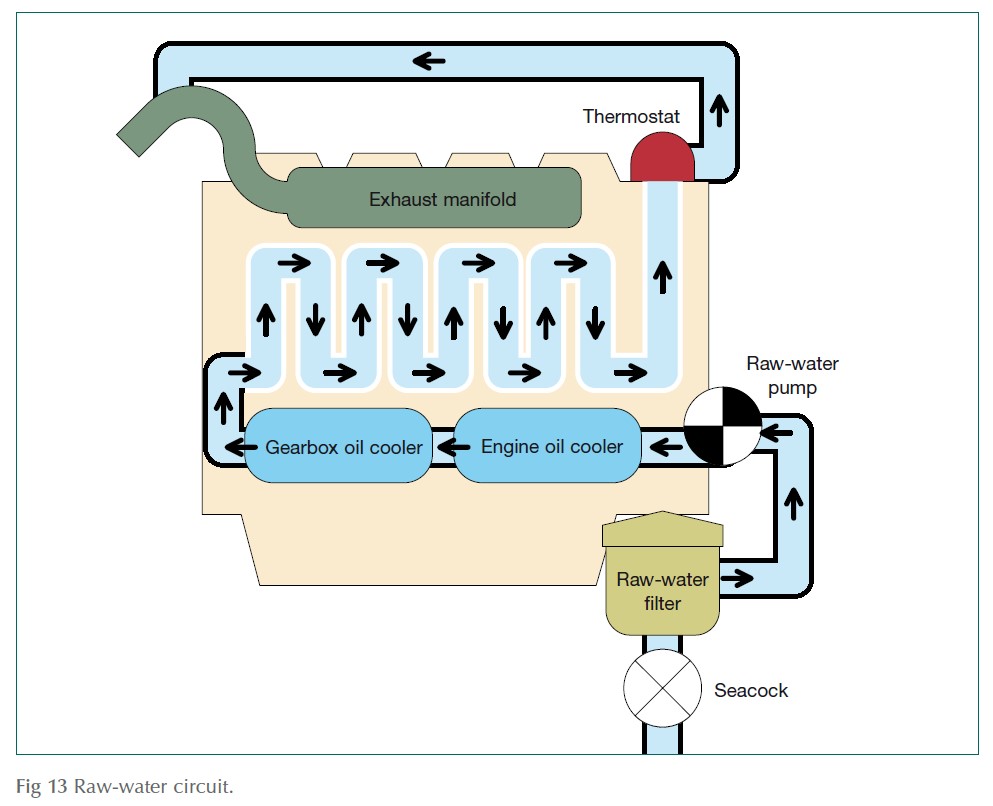
Once the water has done its job of cooling the engine, it can be discharged overboard through a hole in the topsides. Nowadays, though, it’s much more common for it to be mixed with the engine’s exhaust gas in the injection bend, where it cools and quietens the exhaust system. To reduce the risk of water from the cooling system flooding the exhaust manifold when the engine is not running, an anti-siphon valve is usually built in just before the injection bend.
The thermostat
One drawback of raw-water cooling is that it can be too effective, especially when the engine is being started, or when it is running at low load. The engine needs some heat to ignite its fuel, so removing heat through the cooling system can be counterproductive.
To overcome this, and allow the engine to start and run at its most efficient temperature, most diesels are fitted with an automatic valve called a thermostat, which regulates the flow of cooling water.
The thermostat is usually mounted under a dome-shaped cover where the cooling water leaves the cylinder head. It’s a simple component, whose only moving part is a circular trapdoor of thin metal, held shut by a spring. Under the trapdoor is a sealed capsule of wax or alcohol that expands as the temperature of the surrounding water rises until it overcomes the resistance of the spring and pushes the trapdoor open.
If the thermostat were 100 per cent effective at shutting off the water flow, there would be quite a build-up of pressure between the pump and the thermostat, so the thermostat has a small bypass hole to allow some water to flow when the thermostat is shut. Even if there’s a separate bypass hose, the hole has an important role. Without it, an air lock could keep the cooling water away from the thermostat – thereby stopping it from opening until the temperature of the engine had already risen dangerously high.
It’s worth bearing in mind that there is bound to be a slight difference between the temperature at which the thermostat opens and the temperature at which it closes, so if you watch the temperature gauge closely you may well see a slow and fairly regular rise and fall in engine temperature. This is nothing to worry about: just get used to the normal range of operating temperatures for your engine.
Thermostats can occasionally jam open or closed. If yours jams open, the immediate effect will be that the fluctuation of engine temperature stops, and the engine runs cooler than usual, burning more fuel but producing less power and more smoke.
A more serious problem arises if the thermostat jams shut: the bypass flow alone won’t be enough to cool the engine, so it will overheat.
It’s easy to test a thermostat by taking it out and putting it in a saucepan of water on the stove. As the water temperature rises, you should see the thermostat open. This should happen when the water is too hot for you to bear to put your hand in it, but well before it reaches boiling point.
If the thermostat has failed, a get-you-home solution is to break the wax capsule and spring away to allow the trapdoor to stay open.
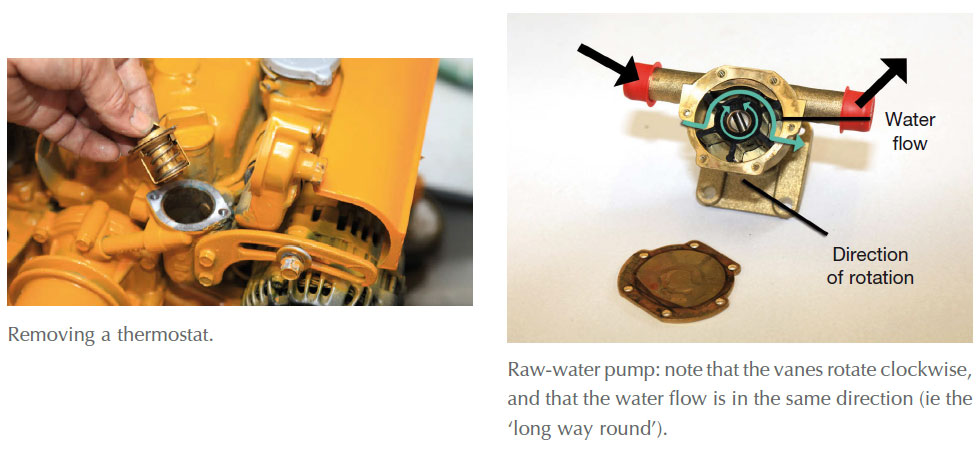
Raw-water pump
There are many different ways of pumping water for raw-water systems, but the most common by far is the ‘flexible impeller’ type of pump – often known by the trade name Jabsco.
The flexible impeller looks like a paddle wheel, with several flat blades or vanes sticking out from a central hub. It’s a tight fit inside a cylindrical casing, and is made even tighter by a bulge in the wall of the casing, between the inlet and outlet pipes.
As the impeller turns, each vane in turn has to bend to get past the bulge. This reduces the space between the bent vane and the one in front. As the vane clears the bulge, it straightens out again, increasing the space between the two vanes and pulling water in from the inlet pipe. As the impeller continues to rotate, the water trapped between the two vanes is carried around with it, until it reaches the outlet pipe. At this point, the leading vane encounters the bulge in the casing and has to bend again to get past it. This reduces the space between the two vanes, and forces the trapped water into the outlet pipe.
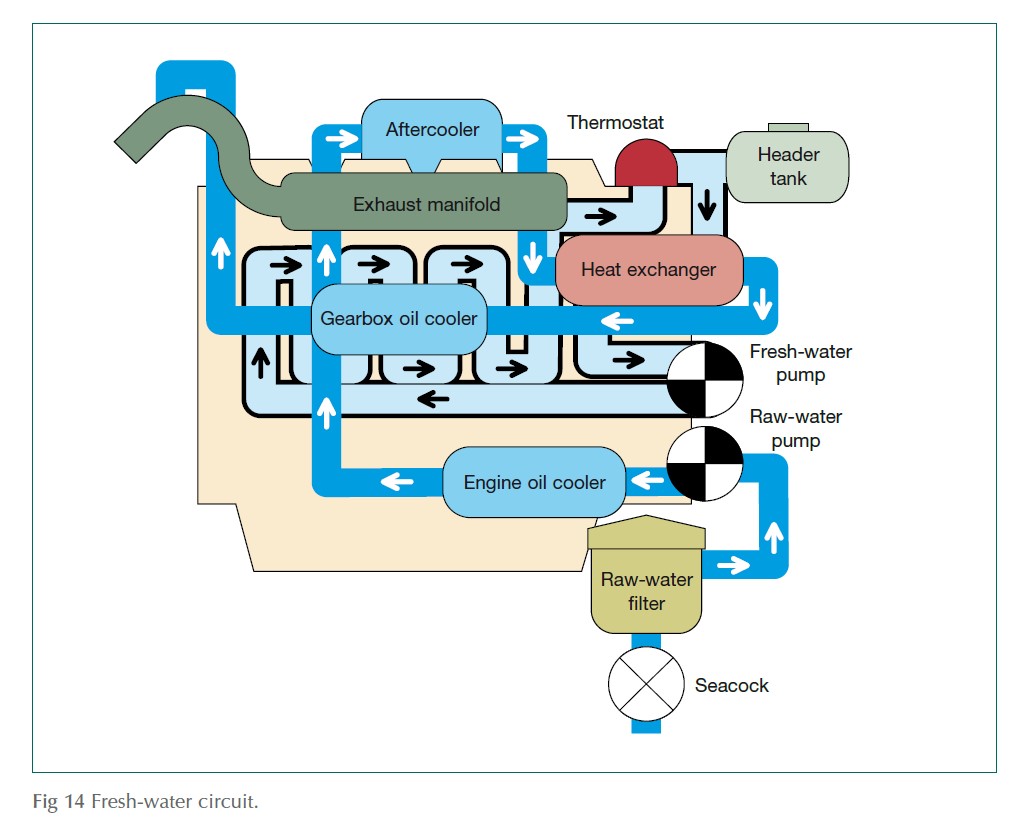
Anodes
Warm sea water is ferociously corrosive, so an engine with raw-water cooling needs something to reduce the effect. Just as most boats have sacrificial zinc anodes below the waterline to protect exposed metal parts, so do most raw-water-cooled engines. Engine anodes come in many shapes and sizes, though they are often in the form of rods, about the shape and size of a man’s finger, which screw into holes in the engine block.
Sacrificial anodes are very effective, but are inconspicuous and easily forgotten, so do check the engine instruction manual to find out where they are and when they should be replaced.
Indirect cooling
An alternative solution to the problem of corrosion is to keep sea water away from the engine altogether, and use fresh water – usually mixed with antifreeze as further protection against corrosion.
This is exactly the same as the way car, truck and tractor engines are cooled, so it is particularly common in engines over about 50 hp (which are almost invariably based on designs intended for use in vehicles).
Fresh-water cooling has other advantages besides reducing the risk of corrosion: it offers closer control of the engine’s operating temperature, and allows it to run slightly hotter without salt deposits building up in the pipe-work. Both of these make the engine more efficient, so fresh-water cooling is gradually becoming more common even on engines as small as 10 hp.
The big difference between a boat engine and its stablemate in a car or truck is that a boat engine doesn’t use an air-cooled radiator to cool the water that has cooled the engine. Instead, it uses a heat exchanger, made up of a bundle of small-bore tubes or thin hollow plates inside an outer casing. The fresh water flows through the casing, while raw (sea) water flows through the tubes or plates.
Fresh-water cooling, then, involves two subsystems: a fresh-water system that cools the engine, and a raw-water system that cools the fresh water. For this reason, it’s often known as indirect cooling.
Apart from the heat exchanger, the components involved in an indirect system are much the same as those that make up a rawwater system, because the raw-water side still has to have a seacock, filter, pump and injection bend. Only the thermostat is missing, because it is now part of the fresh-water system.
Two extra components are involved in the fresh-water side: a header tank to provide a reserve of cooling water and give room for the water to expand and contract as its temperature changes; and a circulating pump to drive water through the system.
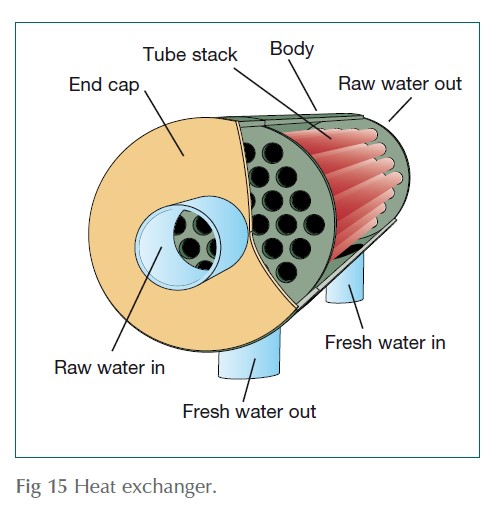
The header tank is often combined with the heat exchanger, to form a substantial box-like component mounted high on the front of the engine. It’s topped by something very much like a car’s radiator cap and serving almost exactly the same purpose – keeping coolant inside the system even when it tries to escape as steam, but acting as a safety valve if the pressure rises too high.
Like a radiator cap, the header tank cap can eventually fail, when the sealing ring is damaged or when the spring loses its resilience. Either of these will lead to a steady loss of water, which could eventually lead to the engine overheating.
Doom and gloom merchants will tell you (quite correctly) that loss of water and overheating are among the symptoms of a blown cylinder head gasket. It could save you a lot of money if you try replacing the header tank cap before leaping to the assumption that the pessimists are right!
Circulating pump
Compared with the raw-water pump, which may have to lift water from the sea, the fresh-water pump has the relatively simple task of creating a flow of water through an enclosed system. This means the pump itself can be the simpler centrifugal type, which is less prone to wear and tear.
The outer casing is dome-shaped, with the inlet pipe at its centre and the outlet pipe emerging from the edge. Inside, the impeller is virtually flat, but has curved vanes sticking up from its surface like the fan of a hover mower. As the impeller spins, the vanes set up a swirling movement of the water inside the casing. Centrifugal force, helped by the curvature of the blades, drives the water out into the outlet pipe, while more water rushes in through the inlet pipe to fill the space that would otherwise be left in the centre.
There is little to go wrong with a centrifugal pump until – after several thousand hours’ running – the bearings that support its shaft start to wear, producing a high-pitched and almost continuous squeak. When this happens, it’s a fairly simple job to rebuild the pump with new components and even easier to replace the whole thing.
Skin cooling
A variation on indirect cooling, popular in steel canal boats and some small commercial vessels, is known as skin cooling or by the somewhat misleading name of ‘keel cooling’.
Essentially it replaces the heat exchanger with tubes or with a tank that is in direct contact with the side or bottom of the vessel. Coolant passing through the tank or tubes discharges its heat through the metal skin of the vessel, into the surrounding water.
Skin cooling systems require very little in the way of maintenance, but it is important to check the coolant level regularly, and to make sure any hoses are in good condition. Every couple of seasons or so, replace the coolant with a fresh mixture of antifreeze and water.
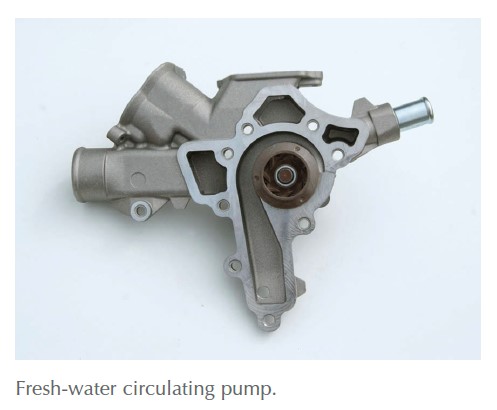
Oil cooling
One tends to assume that an engine needs oil for much the same reason as a bicycle or a door hinge – to reduce friction so that things move or slide over each other more easily. That, however, is only one of its jobs: it also plays an important part in carrying heat away from the engine’s most intimate working parts. Some engines, for instance, even have a system that squirts a jet of oil against the underside of each piston.
In a car, the heat that the oil has collected as it travels around the engine is dissipated from the sump, hanging down below the engine in the rush of air passing under the vehicle.
For obvious reasons this doesn’t apply to marine engines, so many – particularly those over about 50 hp – have an oil cooler.
An oil cooler is another heat exchanger, similar to the main heat exchanger but smaller, that uses the engine’s raw-water system in order to cool the oil. A second oil cooler is often used to cool the gearbox oil.
... Things to do
SAFETY FIRST
Remember that when the engine is warm, the fresh-water system may be full of very hot water or steam, and under pressure.
The raw-water system is directly connected to the sea. Any leak is potentially capable of sinking the boat.
1. CLEARING THE RAW-WATER FILTER
The raw-water filter should be checked, and cleared if necessary, each day that the engine is to be used, and whenever there is an unusual rise in engine temperature.
If your filter has a transparent cover, putting a table-tennis ball inside can save time and trouble because movement of the table-tennis ball is a clear sign that water is flowing through the filter. Otherwise, when you start the engine, get into the habit of checking that water is coming out of the exhaust pipe.
Raw-water filters differ in design and construction. In general, though, the procedure is:
- a. Shut the raw-water seacock.
- b. Remove the cover: this may involve undoing several nuts, unscrewing the cap as though you were opening a jam jar, or releasing a clamp.
- c. Remove the filter element – usually a cylinder of perforated sheet metal, wire gauze, or a net of nylon mesh covering a metal frame – and clear out any weed or debris.
- d. Put the filter back, making sure that any locating studs fit into their notches, and that the top of the filter is at the same level as it was before.
- e. Replace the filter cover, making sure that it is screwed down hand-tight.
- f. Open the seacock and inspect for leaks around the cover. Don’t be tempted to leave this while you do your other daily checks – it’s too easy to start the engine with the seacock closed!
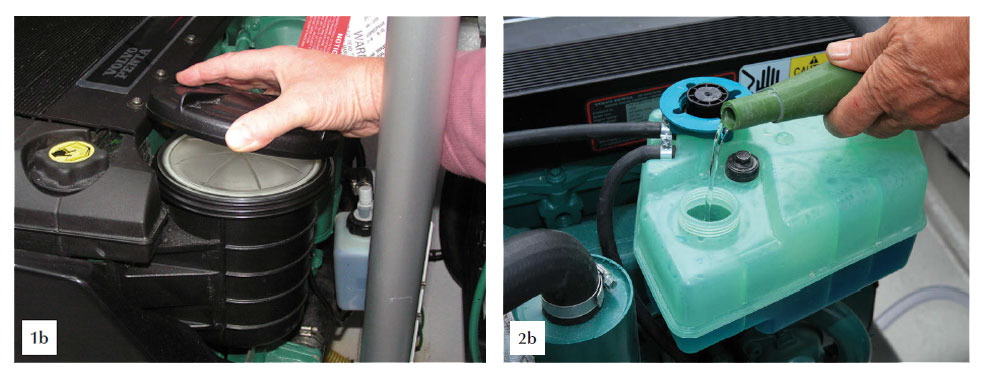
2. CHECKING THE HEADER TANK
If your engine has an indirect cooling system, the level of water in the header tank should also be checked whenever you check the raw-water filter.
- a. Unscrew the header tank cap. If the engine is warm, protect yourself by covering it with several layers of cloth (such as an old towel), and unscrew it very slowly to allow any pressure to be released gradually. Some types have a ‘bayonet’ fitting: these have to be pressed down against the spring pressure before they can be unscrewed, but take only a quarter turn to release: some have a twostage unscrewing action that allows them to be partly unscrewed to release any pressure, then require a second push-and-twist action to release them completely.
- b. Most manufacturers recommend that the water level should be between 1 and 3 in (25 and 76 mm) below the top of the tank: in general, if you can touch the water with your finger, it’s full enough. If not, top it up with clean fresh water mixed with antifreeze. Replace the cap.
3. REPLACING THE RAW-WATER PUMP IMPELLER
Although ‘Jabsco’-type pumps are virtually standard, there are many different models, so it’s a good idea to carry at least one spare on board, because the impeller will very quickly be damaged if the pump is run dry. If the flow of cooling water stops, or the engine shows signs of overheating, check the filter first, then the pump impeller.
- a. Undo the screws holding the pump’s front cover in place, and remove it. Peel away the remains of the paper gasket that may be stuck to the cover, or the body, or a bit of both.
- b. Pull out the impeller with a pair of pliers. If it won’t come out, or if you have no suitable pliers available, it can be prised out using two screwdrivers, but be very careful not to damage the softer metal of the pump body.
- c. If the impeller has disintegrated, try to piece it together so as to be certain there are no missing pieces wandering around the cooling system, where they could cause blockages later. If there are any missing pieces, try to find them if you can: dismantle the pipe-work between the pump and the heat exchanger to see if they are stuck at a bend, or look in the heat exchanger itself.
- d. Smear the new impeller with washing-up liquid, and slide it on to its shaft, making sure that the vanes are bent the right way and that it is properly located on the drive key or pin that protrudes from the shaft. Notice that the water always takes the ‘long way round’ in its trip from the inlet pipe to the outlet and that the vanes trail backwards like the sparks from a Catherine wheel.
- e. Use a little water or washing-up liquid to temporarily stick the new gasket that is supplied with the impeller in place on the pump body, and then replace the cover plate.
4. REPLACING INTERNAL ANODES
Check with your engine instruction manual to see how and when to replace internal anodes.
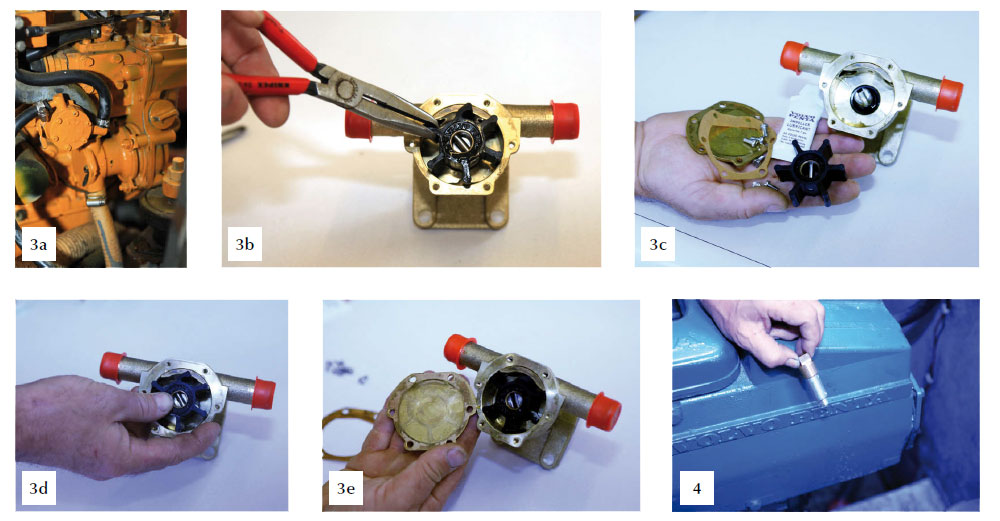
References
Adlard Coles Book of Diesel Engines

